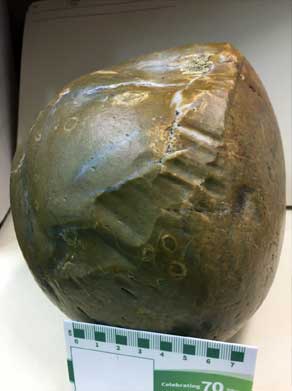Eggbert – A Story of Discovery and Resilience
Dr. Janis Dale, P.Geo. FGC
Eggbert is my favourite rock. He is a quartzite (a type of preserved metamorphic rock) shaped like an egg and the size of a small yet very heavy bowling ball.
As a professor of geoscience, I love taking Eggbert to my geology classes to explain his amazing life as a rock. He has travelled around central North America and his resulting features can teach us about the past.
I came across Eggbert more than 15 years ago on a geology field trip through Cypress Hills. We were walking across a field south of the Conglomerate Cliffs when I tripped over him. I took a closer look and discovered that I had stumbled upon a ventifact — a rock formed by the wind. I could see where the winds and sand had polished the surface and made grooves by sandblasting it.
I realized that Eggbert was part of a whole field of ventifacts obscured by grasses and weeds. Here we were on route to a geological feature and nobody noticed that we were traversing over one — the rare discovery of a field of ventifacts most often found in desserts.
How did Eggbert get there? The scars tell the story. He was a quartzite rock that probably came from the Sweet Grass Hills that formed in the south when the Rocky Mountains were rising and channels developed across the prairies.
These rocks were picked up by glaciers and transported. Percussion marks (small circular fractures) on the side of Eggbert that has not been sandblasted show his tale of riding strong and turbulent streams, banging into other rocks and becoming rounded.
He travelled a long distance before landing for awhile only to be picked up again by glaciers. He was finally deposited with a group of his friends in a field where katabatic winds developed (strong gravitational winds). Glaciers are very windy places. As the wind blew, it picked up sand and silts and sandblasted Eggbert. As time wore on, he eventually became covered in vegetation.
In Eggbert, we can learn a lot of things from one rock — how he was formed, exposed, eroded, caught up in streams, transported to prairies, dumped in a field, polished by wind and overgrown with plants.
There is a lot that went on that might not be apparent from a glance. From a single rock, I can take my students back in time and look at the geological processes of the birth of the Rocky Mountains, the development of great streams across the prairies, and the behaviour of glaciers.

